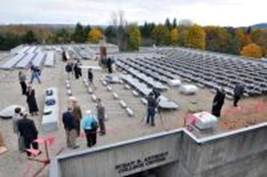In the News
CALENDAR OF EVENTS |
Action Alert - Changes to BioMass Renewable Energy Certificates |
EPA Grants Will Help Communities to Cleanup Land in Maine and Massachusetts The grants are part of an award of $4 million in assistance to 23 communities, many in under-served and economically disadvantaged areas, to develop area-wide plans for the reuse of brownfields properties. The plans will integrate site cleanup and reuse into coordinated strategies to lay the foundation for addressing community needs such as economic development, job creation, housing, recreation, and education and health facilities. EPA’s Brownfields program helps revitalize former industrial and commercial sites, turning them from problem properties to productive community use. “EPA's efforts to help New England communities reclaim brownfields has been a powerful economic force bolstering our economy and strengthening our communities,” said Curt Spalding, regional administrator of EPA's New England office. "We are proud that this program has a proven track record, helping to jump start local economies, putting people to work assessing, cleaning and reclaiming abandoned parcels, returning property to productive uses." EPA will work with the Pioneer Valley Planning Commission, the City of Lowell and the Town of Sanford to identify ways their planning efforts can utilize local, state and federal resources to help implement area-wide efforts for housing, transportation, economic growth and healthy communities. The grant recipients will be able to leverage the Partnership for Sustainable Communities, a joint effort of EPA, the Department of Transportation, the Department of Housing and Urban Development and the Economic Development Administration, to identify potential resources to help move the community plans forward. EPA is awarding up to $175,000 each per selected recipient to help facilitate community involvement in developing an area-wide plan for a brownfields impacted area, such as a neighborhood, district, city block or corridor. The assistance will be provided through grant funding or agency support. EPA and its partner federal agencies will work with the selected communities to:
All three New England grant recipients are in a category called a Brownfields Area-Wide Planning Pilot Program. The Pioneer Valley Planning Commission is focusing on downtown Chicopee’s West End neighborhood. With a population of 2,025, this area was once home to major manufacturers of textiles, munitions, and shoes, and supported a thriving working-class neighborhood. Today, many former industrial and commercial sites in the area are contaminated and underused. The city has developed a Downtown Revitalization Plan that incorporates the community’s vision for revitalizing the downtown area, including the West End. The area-wide plan will focus on sustainable approaches to brownfields redevelopment, including the use of alternative energy generators, reuse of current infrastructure, and creation of greenspace. More information on the partnership: http://www.epa.gov/smartgrowth/pdf/partnership_year1.pdf EPA’s Brownfields program in New England (http://epa.gov/ne/brownfields/grants.html ) |
MassCEC Awards a Feasibility Study Grant in Peru Last week, the Massachusetts Clean Energy Center (CEC)’s Commonwealth Wind Commercial Initative awarded a feasibility study grant to Lightship Energy. Lightship Energy is a Massachusetts Limited Liability Company formed to pursue wind farm development. |
Students for a Just and Sustainable Future Plan The SJSF Website is new, improved, and active! Please check frequently for blog posts and play-by-play information on the Leadership Campaign. |
Public Comment Period on Housatonic Rest of River Now Open EPA will accept informal public input beginning Friday, October 15, 2010 through Monday, November 15, 2010. GE's Revised CMS is available on the EPA website and is located in the Rest of River section under GE Reports/Corrective Measures Study. The direct link is: http://www.epa.gov/region1/ge/thesite/restofriver-reports.html#CMS The CMS includes GE's recommendations on which alternatives the company believes best meet the objectives and criteria specified for the Rest of River project. This recommendation from GE does not reflect EPA's views on the alternative that best meets the criteria in the permit EPA is reviewing GE's Revised CMS as well as GE’s previous CMS submitted in March of 2008. EPA is now accepting comments from all interested organizations and individuals. After conducting its review and analyses, EPA will propose a cleanup plan for the Rest of River for public comment. Comments may be submitted by mail to: by e-mail to: Jim Murphy |
Nature's sting: The real cost of damaging Planet Earth Biodiversity: The threat to nature And it's not just the number of bees that is dwindling rapidly - as a direct result of human activity, species are becoming extinct at a rate 1,000 times greater than the natural average. The Earth's natural environment is also suffering. In the past few decades alone, 20% of the oceans' coral reefs have been destroyed, with a further 20% badly degraded or under serious threat of collapse, while tropical forests equivalent in size to the UK are cut down every two years. These statistics, and the many more just like them, impact on everyone, for the very simple reason that we will all end up footing the bill. Costing nature A recent, two-year study for the United Nations Environment Programme, entitled The Economics of Ecosystems and Biodiversity (Teeb), put the damage done to the natural world by human activity in 2008 at between $2tn (£1.3tn) and $4.5tn. At the lower estimate, that is roughly equivalent to the entire annual economic output of the UK or Italy. A second study, for the UN-backed Principles for Responsible Investment (PRI), puts the cost considerably higher. Taking what research lead Dr Richard Mattison calls a more "hard-nosed, economic approach", corporate environmental research group Trucost estimates the figure at $6.6tn, or 11% of global economic output. This, says Trucost, compares with a $5.4tn fall in the value of pension funds in developed countries caused by the global financial crisis in 2007 and 2008. Of course these figures are just estimates - there is no exact science to measuring humans' impact on the natural world - but they show that the risks to the global economy of large-scale environmental destruction are huge. Natural services “It's pretty terrifying. Nobody in business thinks that at some point this is not going to hurt us” End Quote Gavin Neath Unilever Businesses and individuals have largely operated on the basis that the natural resources and services that the planet provides are infinite. But of course they are not. And only when the value of protecting them, and in some cases replacing them, is calculated, does their vital role in the global economy become clear. Some are obvious, for example the clean and accessible water that is needed to grow crops to eat, and the fish that provide one-sixth of the protein consumed by the human population. But others are less so, for example the mangrove swamps and coral reefs that provide natural barriers against storms that devastate coastal regions; the vast array of plant species that provide pharmaceutical companies with endless genetic resources used for live-saving drugs; and the insects that provide essential pollination for growing around 70% of the world's most productive crops. Continue reading the main story Drivers of biodiversity loss
|
Razed dams free water Monday October 18, 2010 DALTON -- A pair of century-old, deteriorating dams have been razed on Hathaway Brook, allowing the waterway to flow freely into the Housatonic River. The Lower and Upper Hathaway dams, which were built by Pittsfield in 1893 and 1908 respectively, once held back a reservoir supplying the city with drinking water until the late 1950s. The structures were located near Washington Mountain Road on 5,300 acres of city-owned land in Dalton’s southwest corner. The property also includes the city’s Ashley Lake Reservoir, one of six reservoirs supplying Pittsfield with drinking water. "This project shows the city keeps its obligation to taking care of its infrastructure, piece by piece," said Bruce I. Collingwood, Pittsfield Public Works and Utilities commissioner. |
Is your old oil heating system burning nothing but money?
Only the first 500 eligible applications statewide will receive one of these special rebates. Even if you are not sure of your eligibility, fill out the community mobilizaton form today. |
Drought Update from the Western Mass DEP Circuit Rider All of Western Mass except for Berkshire County is now under a declared drought, retroactive to October 1. The five Worcester County communities in the DEP Western Region (WERO) have been in drought status since August 1. http://www.mass.gov/dcr/watersupply/rainfall/images/droughtmap_oct15_2010.jpg http://www.mass.gov/dcr/news/2010/pr10-10-18eoea.pdf http://www.mass.gov/dcr/watersupply/rainfall/drought.htm Mark Stinson This email was created using recycled electrons. |
College shows off 1,868 new solar panels to the public PITTSFIELD -- The future of Berkshire Community College looks bright. And with the installation of 1,868 new solar panels on its roofs, it better stay that way. The college unveiled the first phase of installation at a press conference on its West Street campus Tuesday morning, drawing a crowd of more than 75 college staff, faculty, students, local and state officials. Later, guests were allowed to tour the installation, which can be seen from the second floor of the college’s Field Administration Building. Upon completion, the array itself, which will stretch over seven buildings, will be the largest roof-mounted photovoltaic array of any state educational institution. The $1.8 million project was made possible with federal stimulus money and low-interest Clean Renewable Energy Bonds. With a capacity of 392 kilowatts and the ability to produce 421 kilowatt hours, the new panels will generate about 25 percent of BCC’s electricity each year. "We’re excited that very soon we will be able to say that BCC is powered by the sun," said BCC President Paul Raverta. He was joined by a panel of speakers at Tuesday’s press conference, including Secretary Ian Bowles of the state Executive Office of Energy and Environmental Affairs, Sen. Benjamin Downing, Mayor James Ruberto; Peter Larkin, chairman of the college’s Board of Trustees, and project manager Dan Small of Ostrow Electric in Worcester. Congressman John Olver and Sen. John Kerry, though not in attendance, were recognized for their contributions in helping to secure federal stimulus dollars to install the array. "Investment in clean energy in Berkshire County is not only an investment for today, but also an investment for tomorrow," said Downing. Officials also touted the fact that the array employed a number of people in Berkshire County and the state. The rooftop systems comprise inverters made by Solectria of Lawrence and panels from Evergreen Solar of Devens. "It’s a great idea and a great step for the college," said Jonathan Dick, a first-year student who attended the press event as part of sustainability class he is taking at the college. Dick said he’d like to see the college go on to improve the system over the years to generate more electricity than the 25 percent it is expected to do. He said, "My classmates and I will be the next generation, the movers and pushers who decide how the world’s going to go, so it’s important to be informed about this to understand how to move forward." |
Job Opening with Defenders of Wildlife Denver Office Defenders of Wildlife is seeking applicants for a Rocky Mountain Representative/Associate (depending on qualifications). The position will be located in the Denver field office or other suitable location in the region. Position Description Essential Duties and Responsibilities
Qualifications
How To Apply It is the policy of Defenders of Wildlife to provide equal employment opportunity to all qualified individuals without regard to their race, color, religion, national origin, sex, age, disability, or any other characteristic protected by law, in all personnel actions. David Gaillard, Rocky Mountain Region Representative |
Job Opening with The Pacific Forest Trust: Vice President – Conservation,
San Francisco, CA |
- Home
- Agencies & Regulations
- News
- Issues
- Volunteers in Action
- Donate or Volunteer


 Right now a new program funded by the American Reinvestment and Recovery Act is offering a limited number of special rebates from $1500 to $3500 that can help you replace your furnace or boiler without breaking the bank. These rebates are in addition to Mass Save incentives AND federal tax credits. In order to be eligible for this special rebate, you must own and occupy either a single family home or own and occupy a unit in a building with 1-4 residential units; meet certain income requirements; and your oil heating system must be at least 20 years old.
Right now a new program funded by the American Reinvestment and Recovery Act is offering a limited number of special rebates from $1500 to $3500 that can help you replace your furnace or boiler without breaking the bank. These rebates are in addition to Mass Save incentives AND federal tax credits. In order to be eligible for this special rebate, you must own and occupy either a single family home or own and occupy a unit in a building with 1-4 residential units; meet certain income requirements; and your oil heating system must be at least 20 years old. 